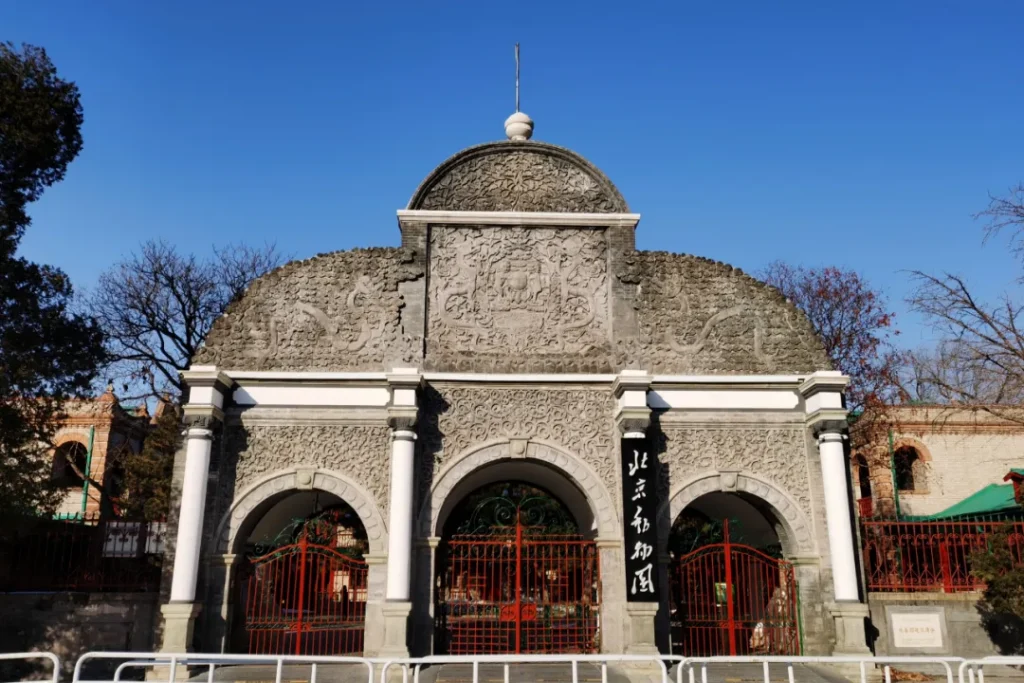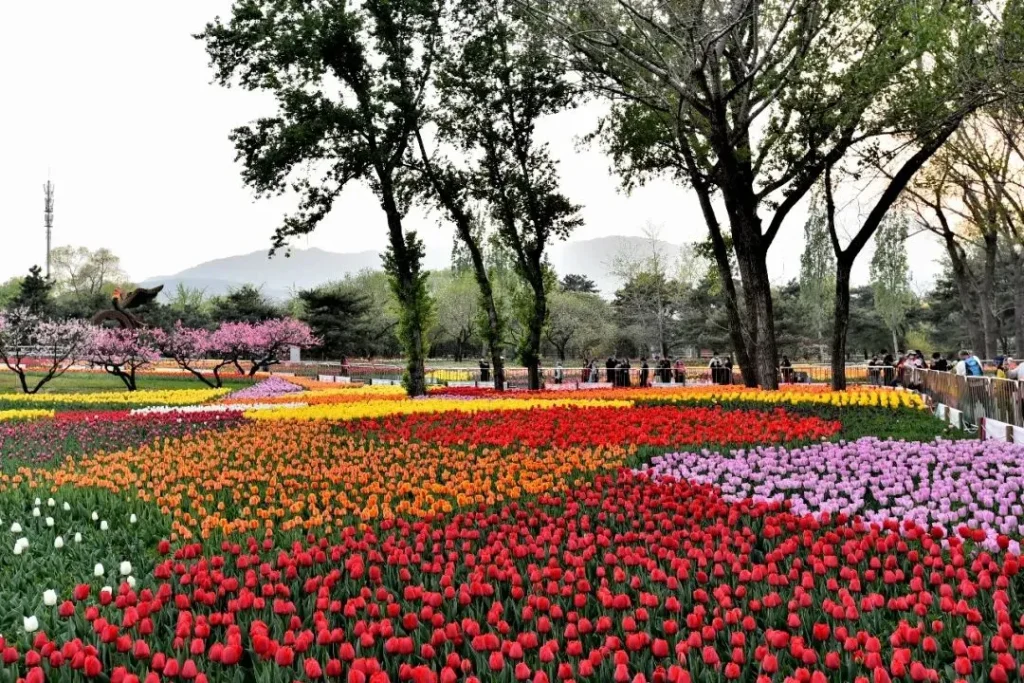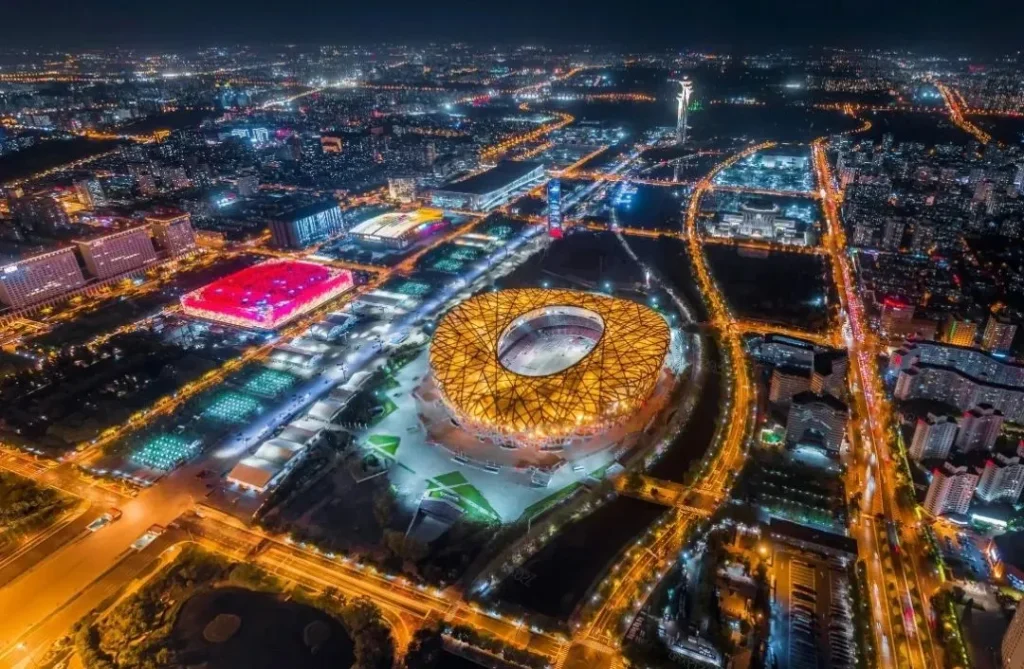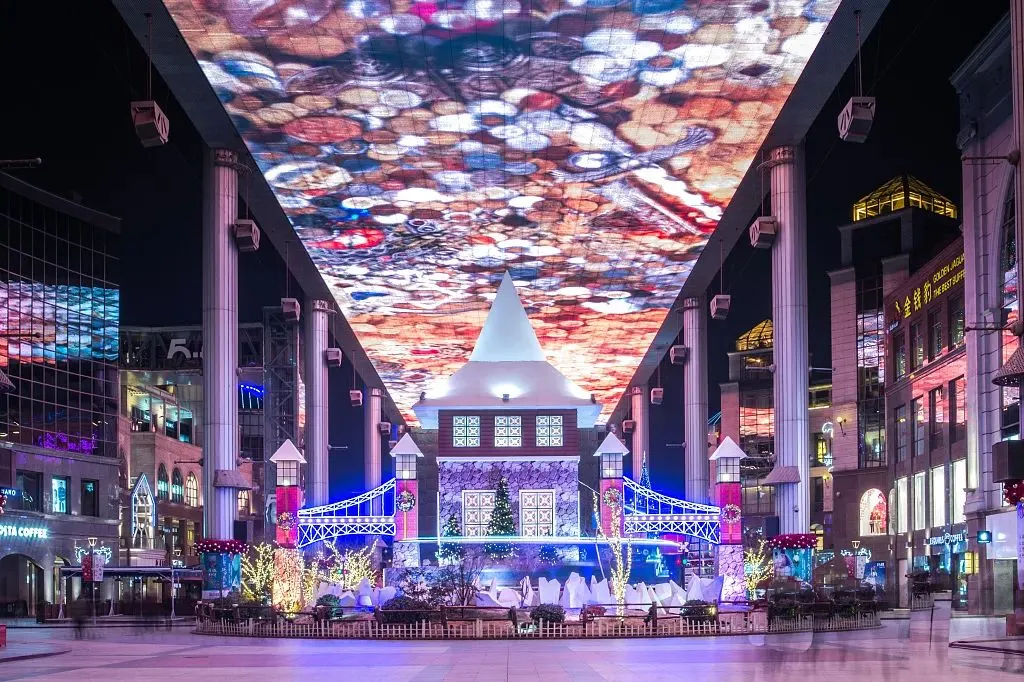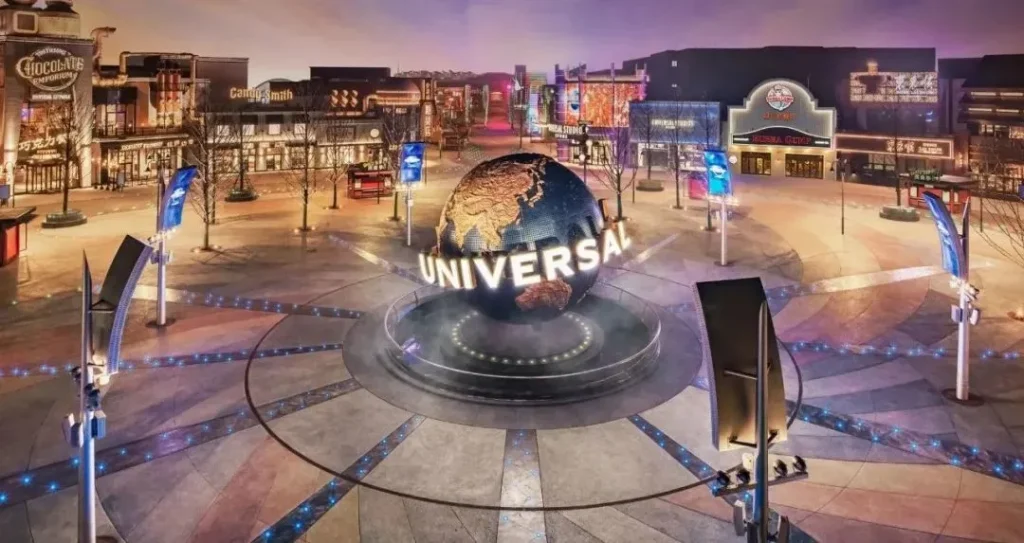
Destinations
This is your gateway to discovering China’s beauty! Whether it’s your first visit or a deeper exploration, we’ve got you covered.
Beijing
As China’s capital, Beijing is a world-renowned travel hotspot and a key highlight for any China travel itinerary, drawing visitors from every corner of the globe with its incredibly rich Chinese history and vibrant Chinese culture. This amazing city, one of the most fascinating cities in China, masterfully blends the essence of millennia-old civilization with the dynamic energy of a modern metropolis, offering a wonderfully diverse experience and countless things to do in Beijing for everyone who visits. Hopefully, this guide will give you a better feel for Beijing’s unique allure and offer some handy China tips for your trip, perhaps even inspiring you to explore a map of China to see its vastness.

- Uncovering History: Beijing's Imperial Grandeur and Timeless Legends – A Glimpse into Ancient China
- Feeling the City's Pulse: Beijing's Modern Energy and Innovative Spirit
- Embracing Nature's Beauty: Beijing's Seasons and Scenic Escapes amidst Beautiful Mountains
- Tasting the Temptation: Beijing's Diverse Culinary Scene – Authentic Chinese Food and More
- Enjoying Retail Therapy: Beijing's Blend of High Fashion and Traditional Crafts
- Your Beijing Adventure: An Unforgettable Journey Through History and Modernity – One of the Best Places to Visit in China
- Recommended Attractions and Activities:
- A Simplified Guide
- Related posts
Uncovering History: Beijing’s Imperial Grandeur and Timeless Legends – A Glimpse into Ancient China
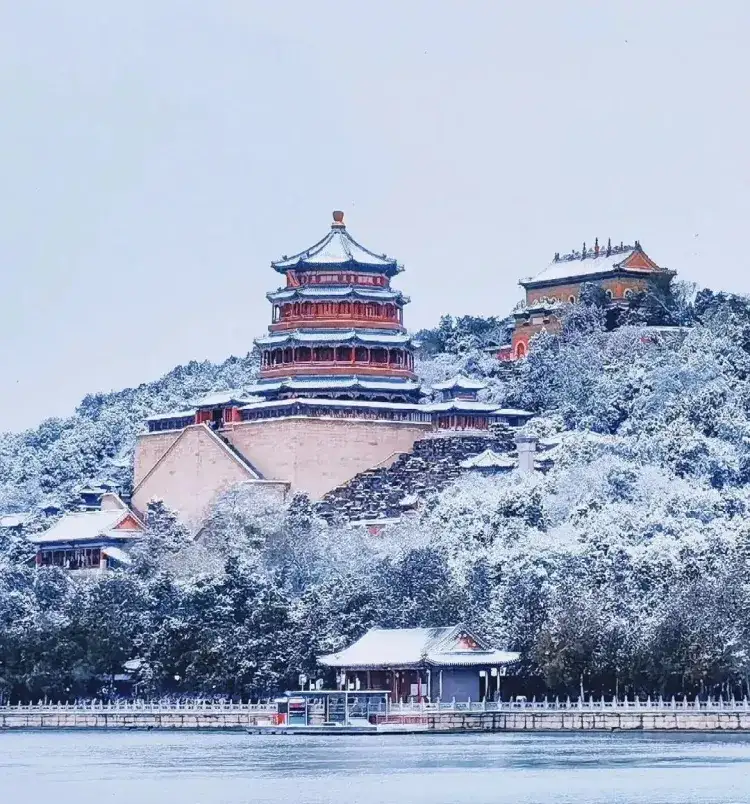
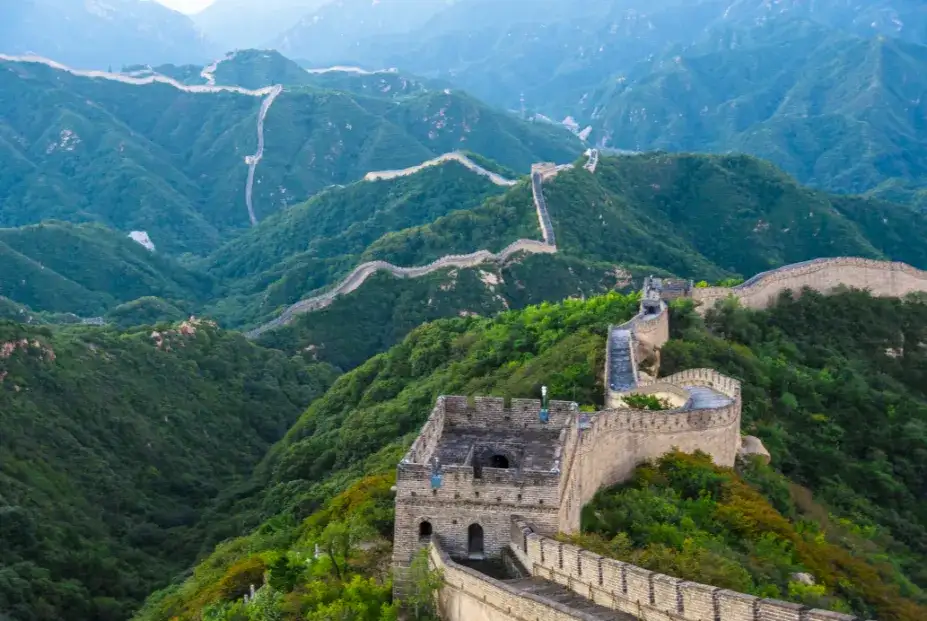

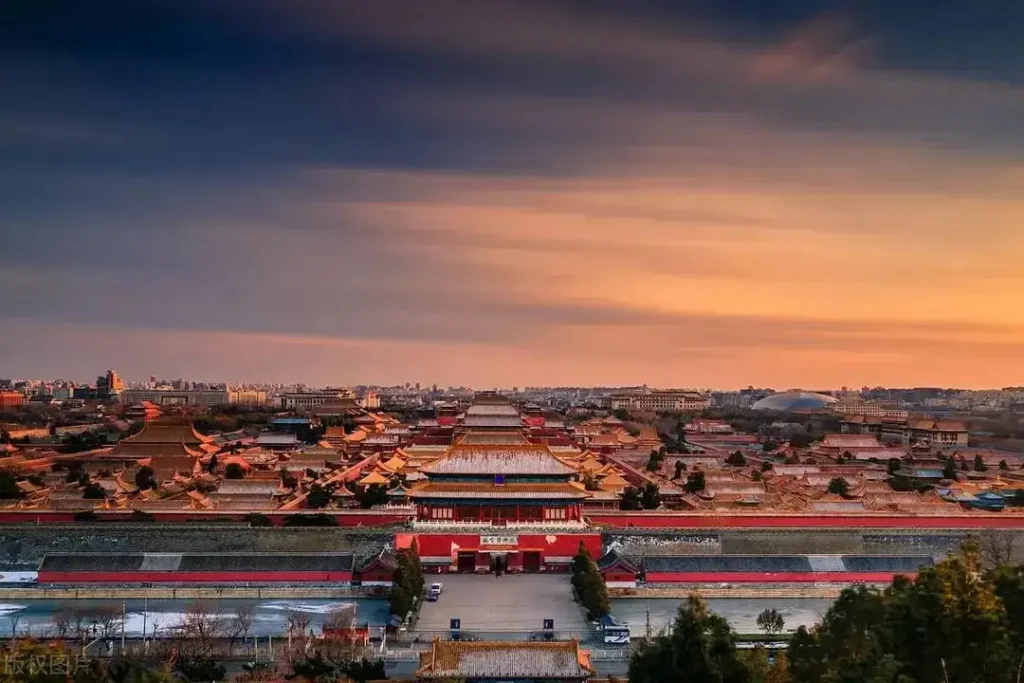

With a history stretching back over 3,000 years as a city and more than 860 years as a capital, Beijing is a true ancient metropolis, deeply woven into the fabric of Chinese civilization, often depicted on any ancient China map. The city’s historical and cultural treasures, especially its magnificent imperial complexes like the Forbidden City, are not just pinnacles of ancient Chinese architecture but global architectural marvels, forming the heart of Beijing’s appeal.
First on your list should be the Forbidden City (故宫博物院), once the imperial palace for emperors of the Ming and Qing Chinese dynasties. It’s the world’s largest and best-preserved ancient wooden palace complex. As you wander through, the majestic halls, intricately carved beams, and countless precious artifacts whisper tales of imperial life and dynastic sagas. Whether you’re there early to dodge the crowds and feel the imperial power before the Hall of Supreme Harmony (太和殿), or poring over exquisite courtly items in the Treasure Gallery, you’ll be captivated by the splendor within these iconic red walls and golden roofs. You might even see visitors in Hanfu or Qipao (Cheongsam), traditional Chinese dress, adding to the atmosphere.
When you think of China, the Great Wall (长城) is undoubtedly one of the first images that comes to mind. This colossal ancient defensive structure, like a giant Chinese dragon winding across rugged mountains, is not only a testament to the wisdom and courage of ancient Chinese laborers but also a breathtakingly scenic wonder. The Mutianyu (慕田峪) section near Beijing, known for its dramatic landscapes and well-preserved fortifications, offers a fantastic Great Wall of China photos opportunity. Climbing the Wall lets you appreciate ancient military ingenuity and feel the enduring spirit of the Chinese nation.
For a taste of imperial garden artistry, head to the Summer Palace (颐和园). This impeccably preserved imperial retreat is famed for its exquisite landscape design and harmonious blend with natural scenery, including serene lakes and classic pagodas. Kunming Lake (昆明湖) shimmers peacefully, Longevity Hill (万寿山) is lush with trees, and the pavilions, corridors, and bridges dotted throughout showcase the pinnacle of traditional Chinese garden art. Whether you’re boating on the lake or strolling along the beautifully painted Long Corridor, the Summer Palace is a haven of imperial beauty and tranquility.
Another unmissable imperial site is the Temple of Heaven (天坛公园), a significant Chinese temple complex. This was where Ming and Qing emperors performed solemn rites to pray for good harvests. Its centerpiece, the Hall of Prayer for Good Harvests (祈年殿), with its unique circular, triple-eaved roof and stunning construction, reflects ancient Chinese cosmology and reverence for nature. A walk through the Temple of Heaven Park offers a profound sense of the “harmony between heaven and humanity” (天人合一) concept in traditional Chinese culture.
These historical sites are more than just tourist attractions; they are living testaments to China’s 5,000 years of civilization. Their unique charm draws visitors worldwide, eager to experience the depth of traditional Chinese culture. As many travelogues describe, a trip to Beijing often involves savoring the “old Beijing” – reliving the bustling grandeur of centuries past amidst these ancient imperial gardens, weathered city walls, and traditional hutong (胡同) alleyways. You might even catch a lion dance or dragon dance during festive seasons.
Feeling the City’s Pulse: Beijing’s Modern Energy and Innovative Spirit

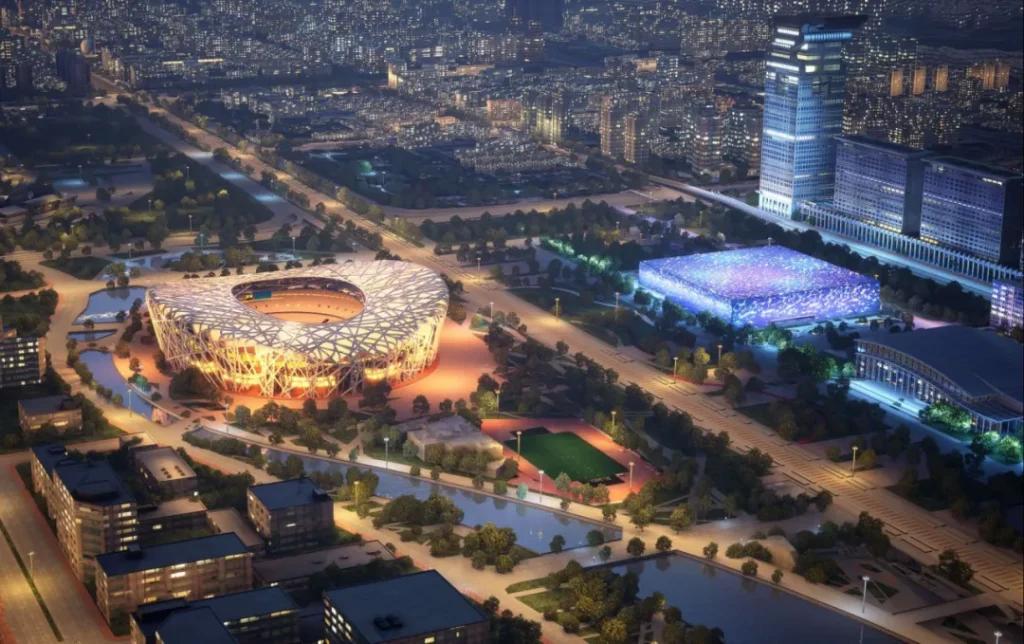

Beijing isn’t just about its glorious past; it’s also a buzzing, modern international city. Its contemporary cityscapes stand in fascinating contrast to the ancient imperial architecture, together creating Beijing’s distinctive urban identity and showcasing China’s rapid development and global influence.
Take a stroll through the Central Business District (CBD) (中央商务区), where towering skyscrapers and sleek commercial buildings sketch out Beijing’s impressive skyline as a global metropolis. This is the city’s economic and commercial heart, brimming with dynamic energy and a modern vibe – a perfect window into contemporary urban life.
The Olympic Park (奥林匹克公园) stands as a proud legacy of the 2008 Beijing Olympics. The iconic “Bird’s Nest” (国家体育场) and “Water Cube” (国家游泳中心), with their groundbreaking designs, have become new city landmarks. These modern marvels not only hosted Olympic dreams but now serve as major cultural venues and popular attractions, celebrating the allure of modern sports culture.
If you’re looking for an artistic fix, the 798 Art District (798艺术区) is a must-visit. Transformed from old factory buildings, this creative hub is now a vibrant collection of galleries, design studios, trendy shops, and unique eateries. As you wander its streets, the sculptures, graffiti art, and industrial-chic architecture exude a strong artistic vibe, attracting artists and art lovers alike and showcasing Beijing’s role as a center for cultural innovation.
These modern cityscapes enrich Beijing’s travel appeal and vividly demonstrate China’s achievements in its modernization journey. Through these contemporary landmarks, visitors can get a real sense of Beijing’s international clout and modern sophistication as the nation’s capital.
Embracing Nature’s Beauty: Beijing’s Seasons and Scenic Escapes amidst Beautiful Mountains


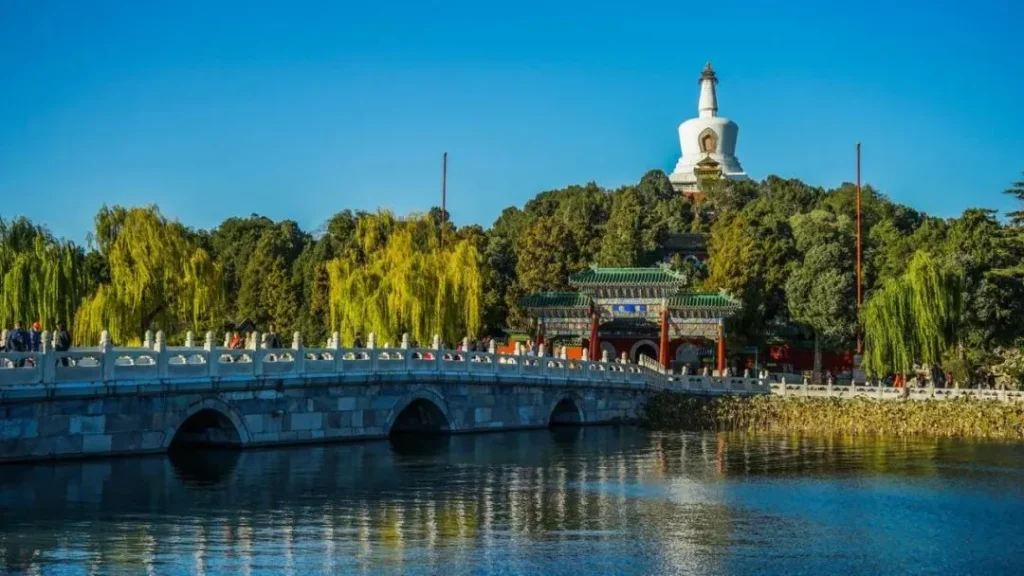

Even though Beijing is a bustling modern city, it’s also blessed with beautiful natural scenery, both in its surroundings and within the city itself, often nestled near beautiful mountains. This offers plenty of chances to enjoy tranquility away from the urban hustle.
Fragrant Hills Park (香山公园) is famous for its stunning red autumn leaves, making it a traditional favorite spot for locals and tourists to enjoy the fall colors. When autumn arrives, the hills blaze with fiery reds and oranges, creating a breathtaking spectacle. Beyond the foliage, Fragrant Hills Park also boasts numerous historical sites, making it a delightful blend of natural beauty and cultural heritage.
The previously mentioned Summer Palace (颐和园), with its Kunming Lake (昆明湖), is a natural masterpiece in itself. The clear waters reflect the surrounding pavilions and the verdant Longevity Hill, offering a refreshing escape whether you’re boating or just strolling along the shore. The Summer Palace masterfully integrates man-made gardens with natural landscapes, creating a harmonious and beautiful environment.
Beijing also has many other distinctive parks and natural areas. There’s the historic Beihai Park (北海公园), where you can relive the classic Chinese children’s song “Let Us Sway Twin Oars.” Jingshan Park (景山公园), located on the city’s central axis, offers the best panoramic views of the Forbidden City. These green oases provide locals with leisure spots and offer visitors a chance to connect with nature and unwind.
Beijing enjoys four distinct seasons, each with its unique natural charm. Spring brings budding life and blooming flowers. Summer is lush, green, and vibrant. Autumn is a riot of color with golden ginkgo leaves and fiery maples under clear blue skies. Winter often brings a blanket of snow, giving the ancient architecture a serene and dignified beauty. Depending on your preferences and travel time, you can choose any season to visit Beijing and experience its diverse natural landscapes.
Tasting the Temptation: Beijing’s Diverse Culinary Scene – Authentic Chinese Food and More
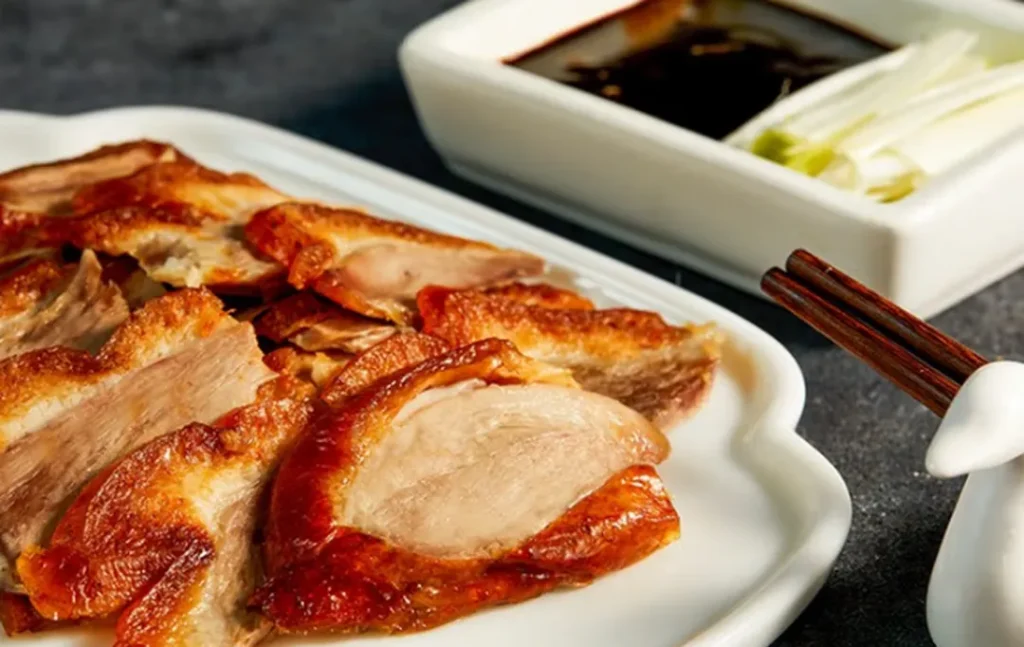
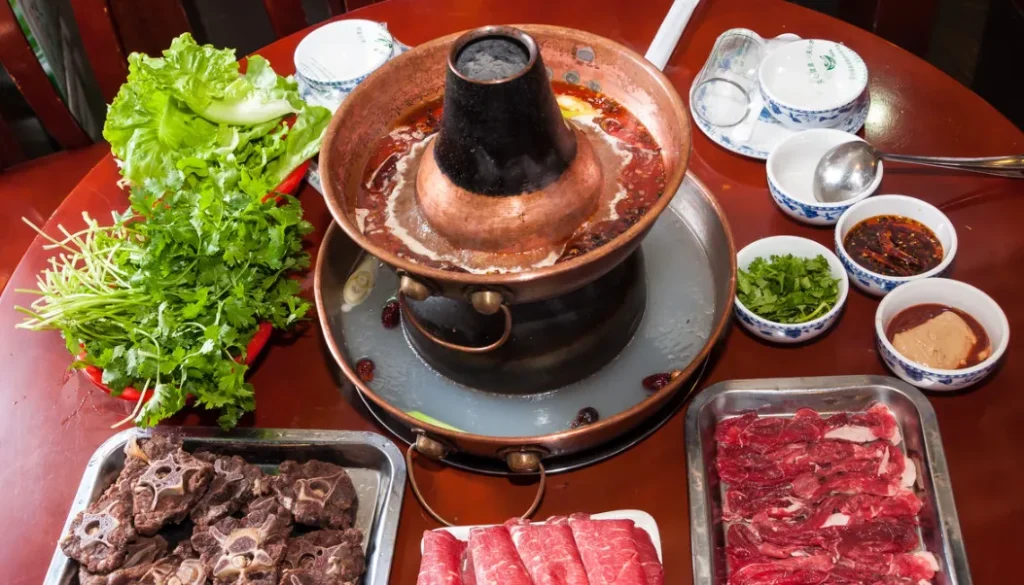


Beijing’s food culture is ancient, diverse, and an absolute must-try for any visitor seeking authentic Chinese food. Beijing cuisine (京菜) is known for its carefully selected ingredients, meticulous preparation, and rich flavors, representing the best of Northern Chinese food.
When talking about Beijing food, the world-famous Peking Duck (北京烤鸭 ) is always at the top of the list. Made from specially bred ducks roasted to perfection, the skin is crispy and reddish-brown, while the meat is tender and succulent. It’s typically sliced thin and served with paper-thin pancakes, sweet bean sauce, and slivers of scallion and cucumber. Wrap it all up, take a bite, and savor the explosion of flavors – it’s an unforgettable culinary icon.
During the colder months, a steaming Mutton Hot Pot (涮羊肉) is the perfect comfort food. This traditional Beijing-style hotpot features thinly sliced fresh mutton cooked Tregs in a light, fragrant broth, then dipped into a rich sesame paste sauce, often with other condiments like fermented tofu and leek flower sauce, alongside various fresh vegetables. It’s more than just a meal; it’s a social experience that reflects the warm hospitality of Beijingers. Don’t forget to try some local Chinese snacks and Chinese desserts alongside your main meals.
For a truly local and adventurous taste, you might try Douzhi’er (豆汁儿). This traditional fermented mung bean drink has a unique, slightly sour and pungent flavor that can be an acquired taste for newcomers. However, when paired with Jiaoquan (焦圈) and pickles, it’s a beloved breakfast staple for many old Beijingers. It might seem simple, but Douzhi’er is steeped in history and local culture.
Beyond these, many other traditional snacks like Zhajiangmian (炸酱面) (noodles with a rich, savory fried meat and bean sauce), Chaogan (炒肝) (a thick stew of stir-fried pork liver and intestines – definitely for the adventurous foodie!), and Lürou Huoshao (驴肉火烧) (a savory “burger” or sandwich filled with braised donkey meat) are integral parts of Beijing’s food scene. These diverse dishes not only tantalize your taste buds but also offer a delicious insight into the city’s unique lifestyle and culinary heritage.
Enjoying Retail Therapy: Beijing’s Blend of High Fashion and Traditional Crafts

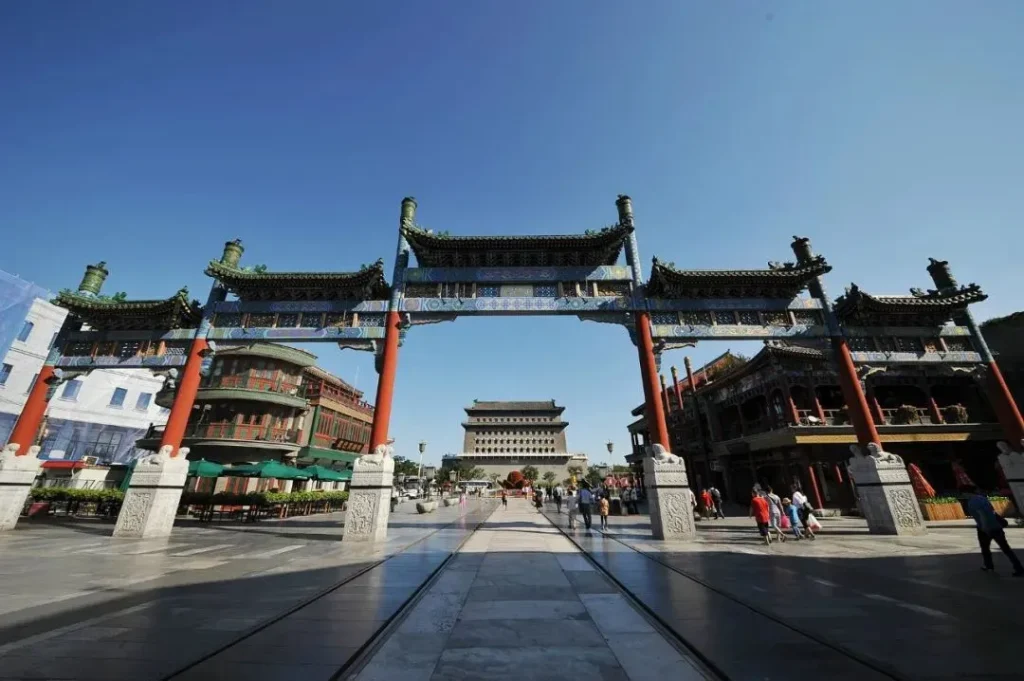


Beijing offers a fantastic and varied shopping experience, from historic, time-honored brands to ultra-modern shopping malls, catering to every taste and budget. While shopping, you can feel the city’s fashionable pulse and appreciate its deep-rooted traditional culture, perhaps finding a beautiful piece of Chinese traditional dress.
Wangfujing Street (王府井大街) is one of Beijing’s most famous commercial hubs. It’s packed with large department stores, brand boutiques, and a dazzling array of snack stalls, making it a bustling center for shopping, dining, and entertainment. You can find cutting-edge international fashion alongside traditional Chinese goods from well-established old shops.
Qianmen Street (前门大街) offers a more traditional Beijing shopping experience. With its renovated Qing-dynasty style architecture, clanging trams, numerous old brand-name shops, and authentic local snacks, it feels like stepping back into old Beijing. It’s a great place to find traditional handicrafts and unique Beijing souvenirs.
Beyond these main streets, Beijing has many specialty markets that offer unique finds. The Panjiayuan Antique Market (潘家园旧货市场) (especially lively on weekends) is a treasure trove for antiques, curios, and art. Liulichang Cultural Street (琉璃厂文化街 ) is famous for calligraphy brushes, ink stones, traditional Chinese paintings, and books. These markets are not just for shopping; they are vibrant cultural spaces where you can soak up local life and history.
Your Beijing Adventure: An Unforgettable Journey Through History and Modernity – One of the Best Places to Visit in China
In a nutshell, Beijing, as China’s capital, is an incredibly captivating city, brimming with historical depth, cultural splendor, modern dynamism, and a vast array of tourism resources, making it one of the best places to visit in China. Whether you’re a history buff, a culture vulture, a nature lover, or a foodie, Beijing has something amazing in store for you.
What makes a trip to Beijing so special is this seamless blend of profound cultural heritage and cutting-edge urban life. You have world-famous historical sites like the Forbidden City, the Great Wall, and the Summer Palace, alongside modern icons like the CBD, the Olympic Park, and the 798 Art District. You can immerse yourself in the solemn mystery of ancient relics one moment and feel the vibrant pulse of a modern metropolis the next.
The city’s natural beauty, delicious food, and diverse shopping also add rich layers to its appeal. After a day of exploring stunning landscapes, treating yourself to an authentic Beijing meal and picking up some unique local crafts will surely round off your experience perfectly.
All in all, Beijing is a city that truly deserves your time to explore and savor. Whether you’re here for a quick visit or a deep cultural dive, Beijing is sure to offer you a rich tapestry of experiences and leave you with wonderful, lasting memories.
Recommended Attractions and Activities:
World Cultural Heritage & Royal Architecture
- Highlights: Imperial palace of Ming and Qing dynasties, one of the world’s top five palaces.
- Address: 4 Jingshan Qianjie, Dongcheng District.
- Highlights: Ancient Chinese defensive fortification.
- Address: Yanqing District.
- Highlights: Ancient imperial sacrificial altar.
- Address: Tiantan Donglu, Dongcheng District.
- Highlights: China’s largest existing imperial garden.
- Address: 19 Xinjian Gongmen Lu, Haidian District.
- Highlights: Showcases research on ancient Chinese anthropology.
- Address: Longgushan, Zhoukoudian Town, Fangshan District.
- Highlights: Imperial mausoleums of the Ming Dynasty.
- Address: East麓 of Tianshou Mountain, Changping District.
- Highlights: China’s most important ancient waterway; Beijing sites include Tonghui River (通惠河), Jishuitan (积水潭).
- Highlights: North-south axis of the city, featuring numerous historical buildings.
Historical & Cultural Sites
- Highlights: Once known as the “Garden of Gardens.”
- Address: 28 Qinghua Xilu, Haidian District.
- Highlights: Exhibits 5,000 years of Chinese civilization.
- Address: 16 East Chang’an Avenue, Dongcheng District (Note: Address in Chinese text was 66, but 16 is more common).
- Highlights: One of China’s oldest imperial gardens.
- Address: Beihai South Gate, Xicheng District.
- Highlights: Excellent spot for a panoramic view of the Forbidden City.
- Address: 44 Jingshan Xijie, Xicheng District (Note: Address in Chinese text was Dongcheng, but it’s on the border, often listed as Xicheng for the main entrance).
Modern Cityscapes
- Highlights: Modern theme park, Hollywood movie world experience.
- Address: 88 Universal Avenue, Tongzhou District.
- Highlights: World’s largest city center square.
- Address: Chang’an Avenue, Dongcheng District.
- Highlights: Modern commercial and cultural complex with a giant LED screen.
- Address: 9 Guanghua Lu, Chaoyang District (Note: Address in Chinese text was 87 Jianguo Lu, The Place is more commonly associated with Guanghua Lu).
- Highlights: Fashionable shopping and dining hub.
- Address: 19 Sanlitun Lu, Chaoyang District (Note: Address in Chinese text was 11, but 19 is the main address for the complex).
Natural Scenery & Parks
- Highlights: Main venues for the 2008 Olympics.
- Address: 1 Lincui Lu, Chaoyang District.
- Highlights: Diverse plant collections.
- Address: Xiangshan Wofosi Lu, Haidian District.
- Highlights: Home to various rare animals, including giant pandas.
- Address: Xizhimenwai Dajie, Xicheng District.
Characteristic Streets & Cultural Experiences
- Nanluoguxiang (南锣鼓巷)
- Highlights: Well-preserved ancient alleyway district, now trendy.
- Address: Nanluoguxiang, Dongcheng District.
- Wangfujing Street (王府井大街)
- Highlights: Traditional commercial street with modern malls and food stalls.
- Address: Wangfujing Dajie, Dongcheng District.
- 798 Art District (798艺术区)
- Highlights: Hub for artists and creative industries in former factory buildings.
- Address: 2 Jiuxianqiao Lu, Chaoyang District (Note: Address in Chinese text was 4, but 2 is more common for the main entrance/area).
- Fangjia Hutong (方家胡同)
- Highlights: Hutong with historical character, now with cafes and small shops.
- Address: Fangjia Hutong, Dongcheng District.
Must-Try Specialty Foods
Iconic Dishes:
- Peking Duck (北京烤鸭): Originating from the Ming Dynasty, a world-famous Beijing specialty.
- Zhajiangmian (炸酱面): Traditional Beijing noodles with a rich, savory sauce.
- Mutton Hot Pot (涮羊肉): A Beijing winter favorite, featuring thinly sliced mutton cooked in a simmering broth.
Traditional Snacks & Drinks:
- Donkey Rolling in Dust (驴打滚): Glutinous rice rolls with red bean paste, coated in soybean flour.
- Mung Bean Milk(豆汁儿): A traditional fermented drink with a unique taste, often served with Jiaoquan (焦圈 – crispy fried rings).
- Pork Entrails Stew with Wheat Cakes(卤煮火烧): A hearty stew with pork offal.
- Stir-fried Liver(炒肝): A thick stew of pork liver and intestines.
- Aiwowo (艾窝窝): A sweet dessert made with glutinous rice and red dates.
Other Popular Choices:
- Lamb Skewers (羊肉串): Flavorful grilled lamb.
- Quick-fried Tripe(爆肚): Crispy beef or lamb tripe.
- Grilled Squid (烤鱿鱼): Crispy on the outside, tender inside.
- Grilled Lobster (烤龙虾): Fresh and juicy.
- Fried Scorpions (炸蝎子): A unique, crispy Beijing snack.
- Fried Yogurt (炸酸奶): Crispy outside, creamy inside, sweet.
- Lotus Seed Soup (莲子汤): A refreshing summer drink.
- Beijing Old Yogurt in Ceramic Jar (北京瓷罐老酸奶): Rich and unique flavor.
- Soy Milk (豆浆): A traditional smooth drink.
- Find these delights at: Nanluoguxiang (南锣鼓巷), Wangfujing Street (王府井大街), Qianmen Old Street (前门老街), etc.
Shopping Recommendations
Traditional & Specialty Streets/Markets:
- Oriental Plaza (东方新天地): Connects Wangfujing and Dongdan commercial streets.
- Beijing New World Shopping Mall (北京新世界商场)
- Beijing Jinbao Place Shopping Mall (北京金宝汇购物中心)
- Xidan Commercial Street (西单商业街): Established area, good for sales.
- Xidan Shopping Mall (西单商场) (Xidan Branch)
- Livat Shopping Centre (聚西红门购物中心) (Xihongmen)
- Chaoyang Joy City (朝阳大悦城)
Traditional & Specialty Streets/Markets:
- Wangfujing Street (王府井大街): Beijing’s only pedestrian commercial street.
- Dong’an Market (东安市场): Traditional market with various goods and snacks.
A Simplified Guide
Best Time to Visit Beijing
Spring (March – May) and Autumn (September – October) are the prime times to visit.
- The weather is comfortable with less rain.
- April, May, September, and October are particularly ideal, with pleasant temperatures.
- Spring offers a vibrant atmosphere; experiencing the “train to spring” is unique. Autumn is cool and perfect for enjoying red leaves and exploring historical sites.
- May is rich in cultural events, often featuring international performances like the annual Heineken International Jazz Festival.
Getting Around (Transportation)
- Subway (Metro): Very convenient with extensive coverage.
- Buses: Numerous routes, an important alternative.
- “Yikatong” (一卡通 – IC Card): Essential for tourists, similar to Hong Kong’s Octopus card. Recharge it to use on buses and subways, avoiding the hassle of buying individual tickets.

